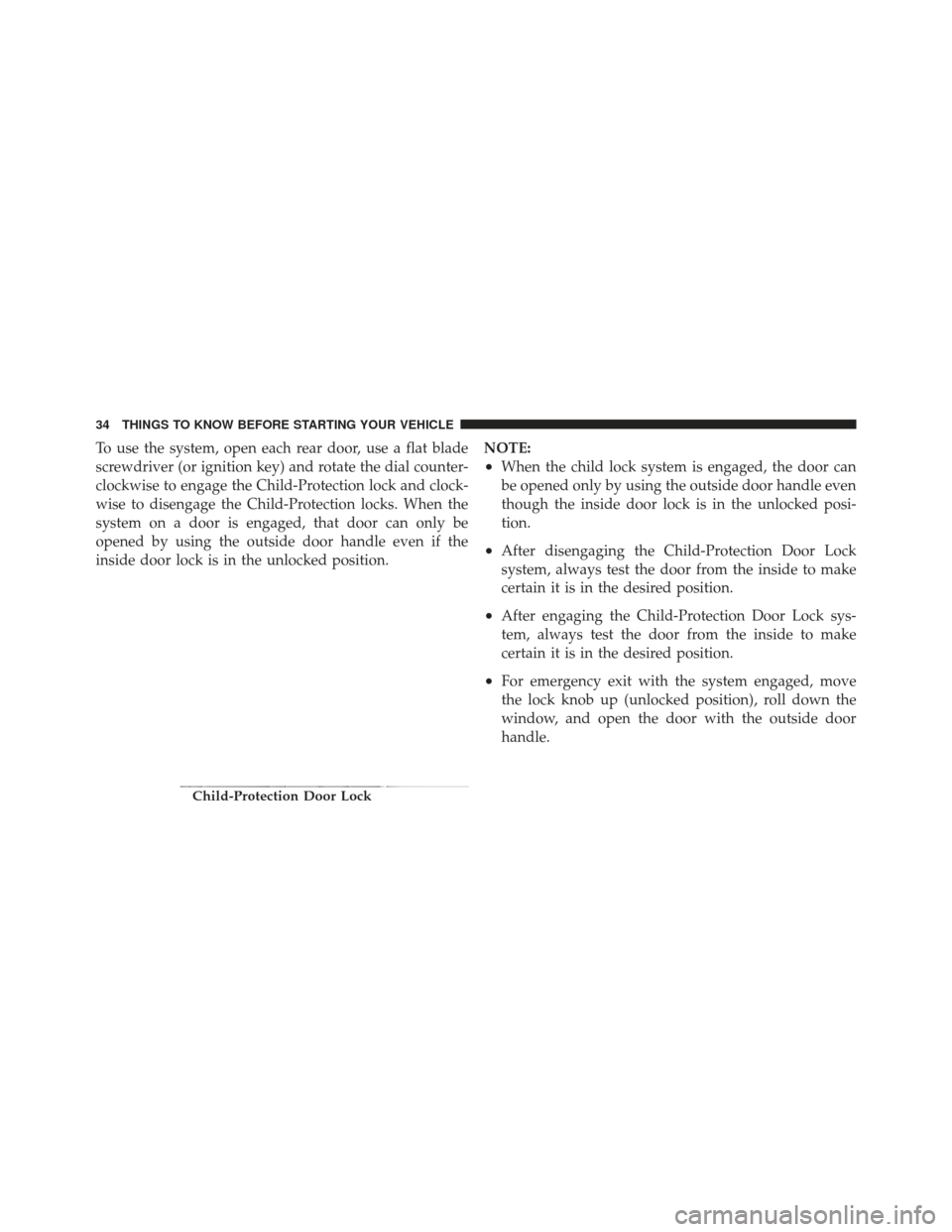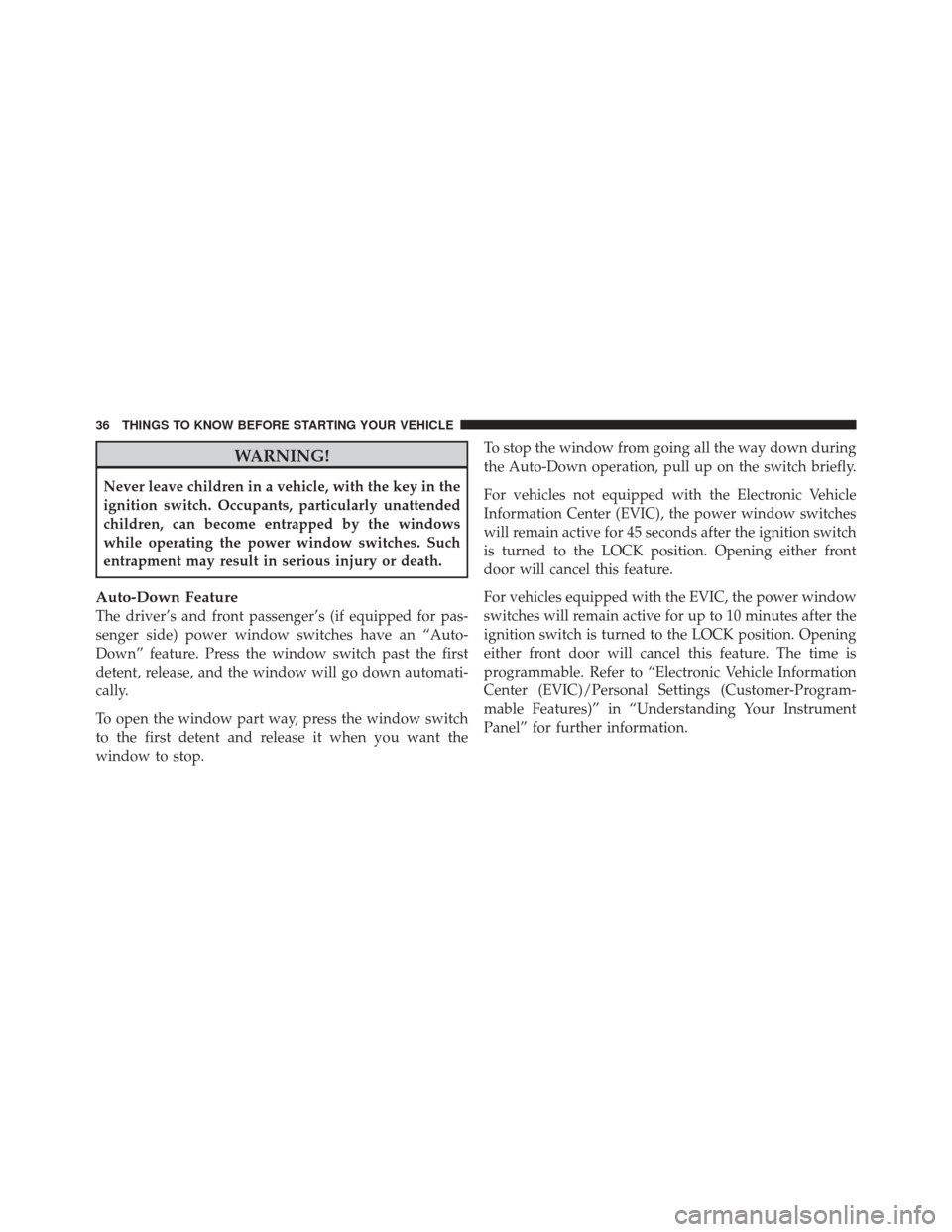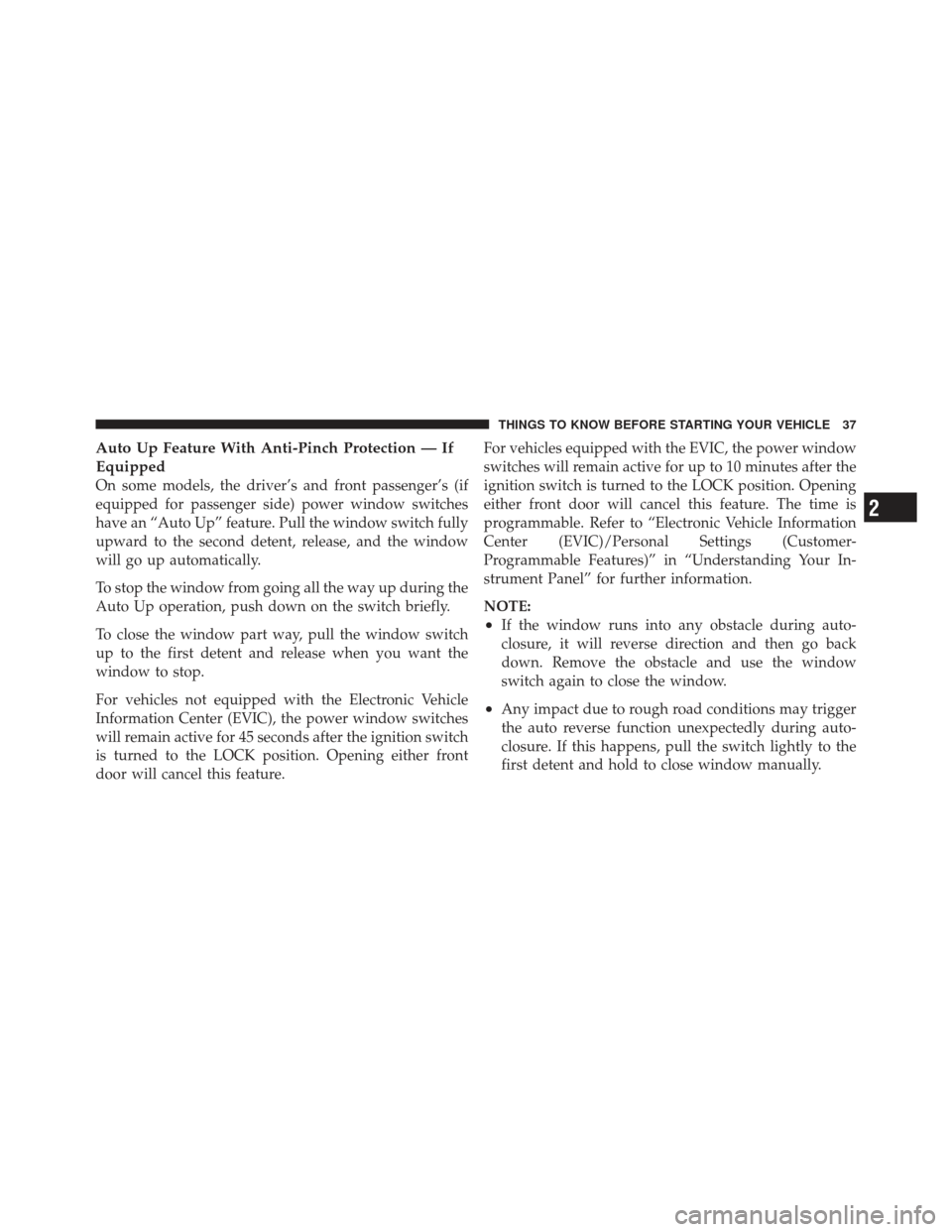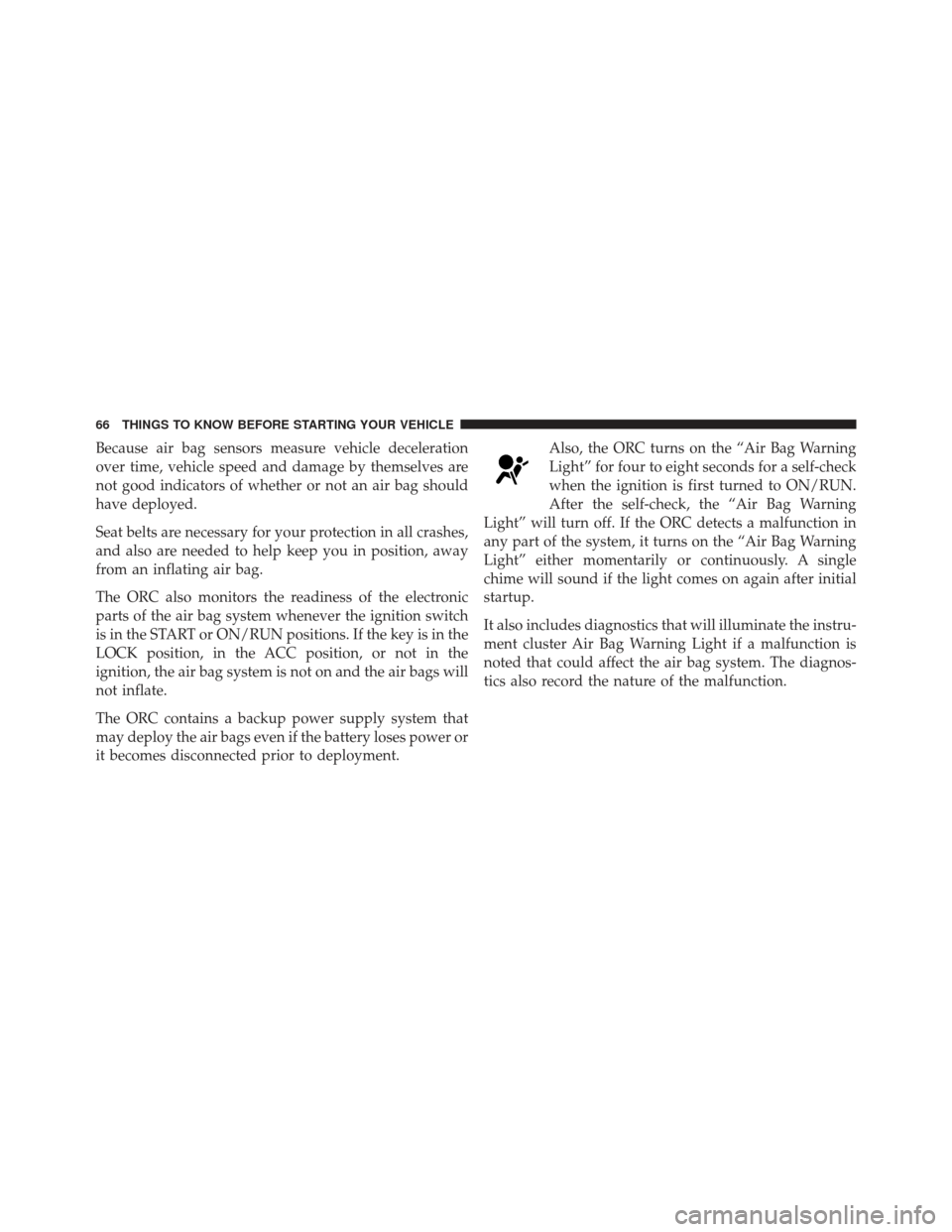Page 35 of 558
•For vehicles not equipped with the EVIC, perform the
following procedure:
1. Close all doors and place the key in the ignition.
2. Cycle the ignition switch between OFF and ON/RUN
and then back to OFF five times, ending up in the
ON/RUN position.
3. Press the power door UNLOCK switch to unlock the
doors.
4. A single chime will indicate the completion of the
programming. Repeat these steps if you want to return this feature to its
previous setting.
NOTE:
Use the Automatic Unlock Doors On Exit feature
in accordance with local laws.
Child-Protection Door Lock System — Rear
Doors
To provide a safer environment for small children riding
in the rear seats, the rear doors are equipped with a
Child-Protection Door Lock system.
2
THINGS TO KNOW BEFORE STARTING YOUR VEHICLE 33
Page 36 of 558

To use the system, open each rear door, use a flat blade
screwdriver (or ignition key) and rotate the dial counter-
clockwise to engage the Child-Protection lock and clock-
wise to disengage the Child-Protection locks. When the
system on a door is engaged, that door can only be
opened by using the outside door handle even if the
inside door lock is in the unlocked position.NOTE:
•When the child lock system is engaged, the door can
be opened only by using the outside door handle even
though the inside door lock is in the unlocked posi-
tion.
•After disengaging the Child-Protection Door Lock
system, always test the door from the inside to make
certain it is in the desired position.
•After engaging the Child-Protection Door Lock sys-
tem, always test the door from the inside to make
certain it is in the desired position.
•For emergency exit with the system engaged, move
the lock knob up (unlocked position), roll down the
window, and open the door with the outside door
handle.
Child-Protection Door Lock
34 THINGS TO KNOW BEFORE STARTING YOUR VEHICLE
Page 37 of 558
WARNING!
Avoid trapping anyone in a vehicle in a collision.
Remember that the rear doors can only be opened
from the outside when the Child-Protection locks are
engaged.
WINDOWS
Power Windows
The window controls on the driver’s door trim panel
control all the door windows.There are single window controls on each passenger door
trim panel, which operate the passenger door windows.
The window controls will operate when the ignition
switch is in the ON/RUN or ACC position.
Power Window Switches
2
THINGS TO KNOW BEFORE STARTING YOUR VEHICLE 35
Page 38 of 558

WARNING!
Never leave children in a vehicle, with the key in the
ignition switch. Occupants, particularly unattended
children, can become entrapped by the windows
while operating the power window switches. Such
entrapment may result in serious injury or death.
Auto-Down Feature
The driver’s and front passenger’s (if equipped for pas-
senger side) power window switches have an “Auto-
Down” feature. Press the window switch past the first
detent, release, and the window will go down automati-
cally.
To open the window part way, press the window switch
to the first detent and release it when you want the
window to stop.To stop the window from going all the way down during
the Auto-Down operation, pull up on the switch briefly.
For vehicles not equipped with the Electronic Vehicle
Information Center (EVIC), the power window switches
will remain active for 45 seconds after the ignition switch
is turned to the LOCK position. Opening either front
door will cancel this feature.
For vehicles equipped with the EVIC, the power window
switches will remain active for up to 10 minutes after the
ignition switch is turned to the LOCK position. Opening
either front door will cancel this feature. The time is
programmable. Refer to “Electronic Vehicle Information
Center (EVIC)/Personal Settings (Customer-Program-
mable Features)” in “Understanding Your Instrument
Panel” for further information.
36 THINGS TO KNOW BEFORE STARTING YOUR VEHICLE
Page 39 of 558

Auto Up Feature With Anti-Pinch Protection — If
Equipped
On some models, the driver’s and front passenger’s (if
equipped for passenger side) power window switches
have an “Auto Up” feature. Pull the window switch fully
upward to the second detent, release, and the window
will go up automatically.
To stop the window from going all the way up during the
Auto Up operation, push down on the switch briefly.
To close the window part way, pull the window switch
up to the first detent and release when you want the
window to stop.
For vehicles not equipped with the Electronic Vehicle
Information Center (EVIC), the power window switches
will remain active for 45 seconds after the ignition switch
is turned to the LOCK position. Opening either front
door will cancel this feature.For vehicles equipped with the EVIC, the power window
switches will remain active for up to 10 minutes after the
ignition switch is turned to the LOCK position. Opening
either front door will cancel this feature. The time is
programmable. Refer to “Electronic Vehicle Information
Center (EVIC)/Personal Settings (Customer-
Programmable Features)” in “Understanding Your In-
strument Panel” for further information.
NOTE:
•If the window runs into any obstacle during auto-
closure, it will reverse direction and then go back
down. Remove the obstacle and use the window
switch again to close the window.
•Any impact due to rough road conditions may trigger
the auto reverse function unexpectedly during auto-
closure. If this happens, pull the switch lightly to the
first detent and hold to close window manually.
2
THINGS TO KNOW BEFORE STARTING YOUR VEHICLE 37
Page 59 of 558

NOTE:
•If you have difficulties or problems resetting the
Active Head Restraints, see an authorized dealer.
•For safety reasons, have the Active Head Restraints
checked by a qualified specialist at an authorized
dealer.
Enhanced Seat Belt Use Reminder System
(BeltAlert�)
BeltAlert�is a feature intended to remind the driver and
front passenger (if equipped with front passenger
BeltAlert�) to fasten their seat belts. The feature is active
whenever the ignition is on. If the driver or front seat
passenger is unbelted, the Seat Belt Reminder Light will
turn on and remain on until both front seat belts are
fastened.
The BeltAlert� warning sequence begins after the vehicle
speed is over 5 mph (8 km/h), by blinking the Seat Belt
Reminder Light and sounding an intermittent chime.
Once the sequence starts, it will continue for the entire
duration or until the respective seatbelts are fastened.
After the sequence completes, the Seat Belt Reminder
Light remains illuminated until the respective seat belts
are fastened. The driver should instruct all other occu-
pants to fasten their seat belts. If a front seat belt is
AHR In Reset Position
2
THINGS TO KNOW BEFORE STARTING YOUR VEHICLE 57
Page 68 of 558

Because air bag sensors measure vehicle deceleration
over time, vehicle speed and damage by themselves are
not good indicators of whether or not an air bag should
have deployed.
Seat belts are necessary for your protection in all crashes,
and also are needed to help keep you in position, away
from an inflating air bag.
The ORC also monitors the readiness of the electronic
parts of the air bag system whenever the ignition switch
is in the START or ON/RUN positions. If the key is in the
LOCK position, in the ACC position, or not in the
ignition, the air bag system is not on and the air bags will
not inflate.
The ORC contains a backup power supply system that
may deploy the air bags even if the battery loses power or
it becomes disconnected prior to deployment.Also, the ORC turns on the “Air Bag Warning
Light” for four to eight seconds for a self-check
when the ignition is first turned to ON/RUN.
After the self-check, the “Air Bag Warning
Light” will turn off. If the ORC detects a malfunction in
any part of the system, it turns on the “Air Bag Warning
Light” either momentarily or continuously. A single
chime will sound if the light comes on again after initial
startup.
It also includes diagnostics that will illuminate the instru-
ment cluster Air Bag Warning Light if a malfunction is
noted that could affect the air bag system. The diagnos-
tics also record the nature of the malfunction.
66 THINGS TO KNOW BEFORE STARTING YOUR VEHICLE
Page 69 of 558

WARNING!
Ignoring the Air Bag Warning Light in your instru-
ment panel could mean you won’t have the air bags
to protect you in a collision. If the light does not come
on as a bulb check when the ignition is first turned
on, stays on after you start the vehicle, or if it comes
on as you drive, have an authorized dealer service the
air bag system immediately.
Occupant Classification System (OCS)
The OCS is part of a Federally regulated safety system
required for this vehicle. It is designed to turn off the
passenger Advanced Front Air Bag for an empty seat and
for occupants classified in a category other than an adult.
This could be a child, teenager, or even an adult.
NOTE:Children 12 years or younger should always
ride buckled up in a rear seat in an appropriate child
restraint.
•Occupant Classification Module (OCM)
The OCM is located beneath the front passenger seat. The
OCM classifies the occupant into categories based on the
measurements made by the seat weight sensors. The
OCM communicates with the ORC. The ORC uses the
occupant category to determine whether the passenger
Advanced Front Air Bag should be turned off. It also
determines the rate of air bag inflation during a collision.
•Weight Sensors
Your vehicle has four Weight Sensors located between the
seat and the floor pan. The weight sensors measure
applied weight and transfers that information to the
OCM.
•Passenger Air Bag Disable (PAD) Indicator Light
The PAD Indicator Light (an amber light located in the
center of the instrument panel) tells the driver and front
passenger when the passenger Advanced Front Air Bag is
turned off. The PAD Indicator light illuminates the words
2
THINGS TO KNOW BEFORE STARTING YOUR VEHICLE 67